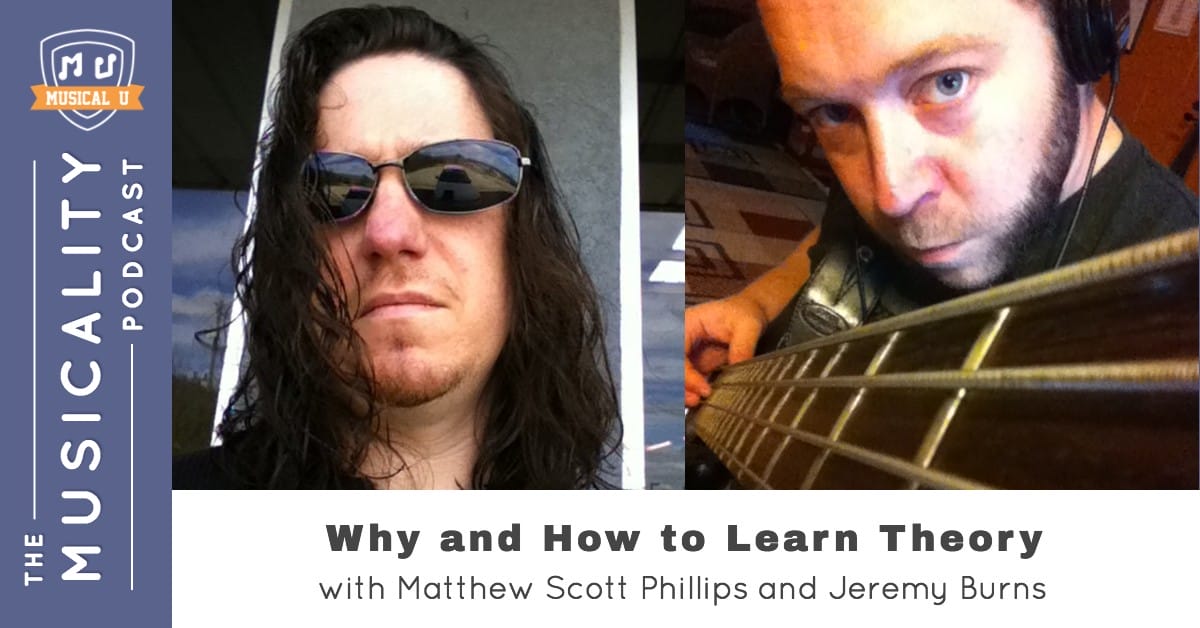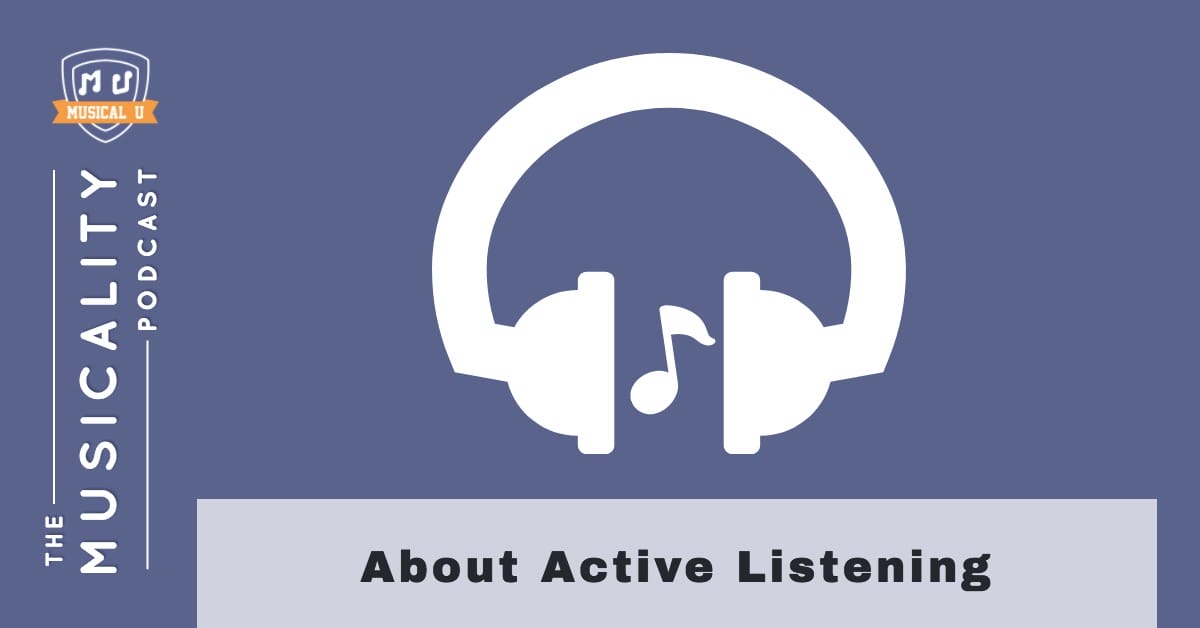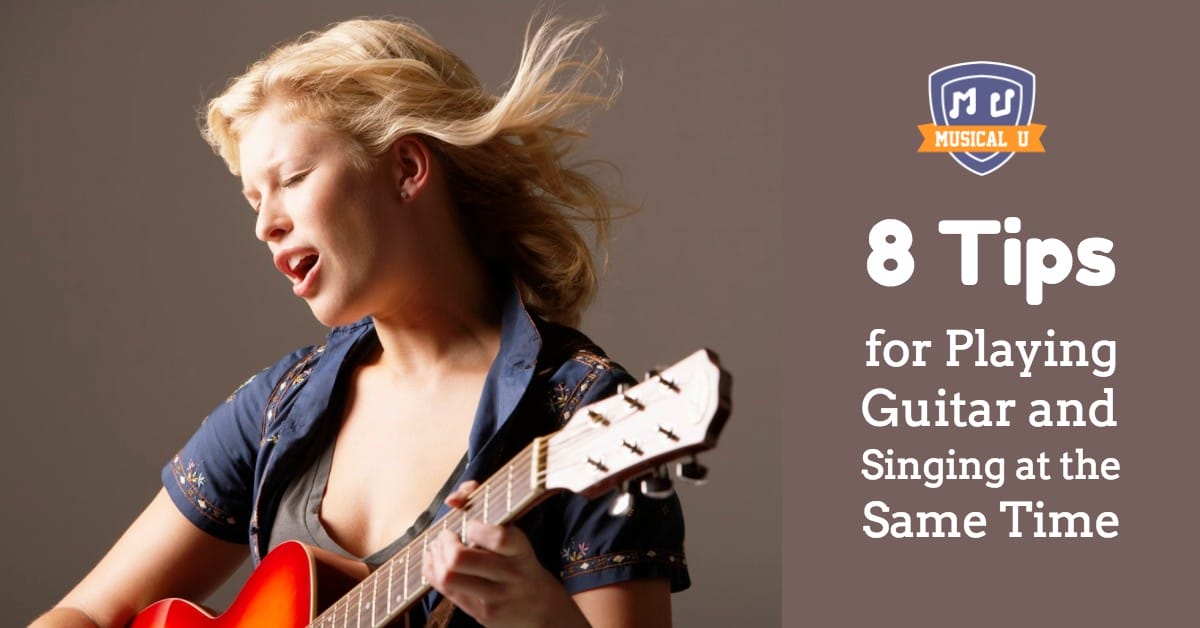There are three central tenets to learning music effectively: theory, ear training, and practice.
This week at Musical U, we have you covered on all three. We first interview the co-hosts of the Music Student 101 podcast to understand how learning theory has helped them achieve success in the music world. We then move on to ear training, specifically the practice of active listening, to understand how it can boost your musicality. And lastly, we move on to actual music practice, with a lesson on how you can train your brain and body to play guitar and sing simultaneously.
Tackling Theory
What happens when you put together an academic music professor/composer with an active performer/sound engineer? Though Music Student 101 podcast co-hosts Matthew Scott Phillips and Jeremy Burns have taken their love for music in different directions, they wholeheartedly agree that learning theory played a major role in their success.
On the Music Student 101 podcast, they take an an accessible, easy-to-understand dive into music theory. We were lucky enough to have them on our own Musicality Podcast, where they spoke to us about how theory has helped them over the years, and how to make theory exciting and pertinent to your own practice. They even took the time to answer the age-old question: is there any point to doing a music degree?
 Tune into this special episode to find out Why and How to Learn Theory, with Matthew Scott Phillips and Jeremy Burns!
Tune into this special episode to find out Why and How to Learn Theory, with Matthew Scott Phillips and Jeremy Burns!
Jeremy and Matthew seemed to “accidentally” find their way to playing the bass guitar out of the needs of other bands and musicians that were in their area. Many have the misconception that bass guitar is simply about holding down the root of the chord for any song. In reality, the bass guitar is much more versatile: it can carry the melody as well as full chords! Mark from Low End University developed a fantastic lesson on playing chords on the bass that left us speechless.
For every benefit to music theory, there are one or two myths that seem to discourage learning more about this valuable subject. Learn Guitar Malta discusses and dispels seven of the most prevalent myths about music theory.
Music theory is a wide and diverse subject, with many different ways of approaching the content and musical styles to consider. Before diving too deeply into any one of these subjects, an overview of music theory and the resources that are available on the internet is very useful. Luckily, Sheet Music Scanner recently published a helpful compilation of resources for those new to music theory, which references great sources like Theta Music Trainer, MusicTheory.net, and Musical U!
A question that is often asked inside Musical U is whether or not music school is a good option to grow musically. There are many resources that can be found at the collegiate level that can help any budding musician grow and become confident on their instrument. To hear a fascinating defense of going to music school, the Outside in Music Podcast interviewed professional Jazz saxophonist Lucas Pino.
Opening Your Ears
A key part of being a musician isn’t just knowing how to play, but knowing how to listen. This involves having a critical ear and paying attention to aspects of music you wouldn’t ordinarily consider.
The benefits of this are plentiful: active listening will help you train your musical memory, learn to recognize intervals and musical motifs, and even imagine music in your mind without having to hear it out loud.
 Check out our primer About Active Listening to learn the simple way you can begin honing this skill today.
Check out our primer About Active Listening to learn the simple way you can begin honing this skill today.
Beginning to actively listen to music is not the easiest task for someone that is used to listening to music purely for entertainment. However, there are steps that you can take to allow your mind to better focus on the task at hand! The Blind Cafe has this simple, four step process to block out all outside distractions and really hear the music in a new light.
Active listening doesn’t have to be a monotonous chore. There are many ways that you can structure your listening to give it a better sense of direction so that you are able to get the most out of the exercise. Solfeg.io has created simple lesson plans that will help you guide your active listening and make it a fun and inspirational exercise.
Of course, active listening is not something that only the instrumentalist must be concerned with. People that work in sound production must learn specific skills that will allow them to be the best producers that they can be. Ask.audio reveals some listening exercises that will benefit your music production skills.
Active listening is not only useful for learning your instrument – it can help you completely transform your playing! A great example of this is learning a new genre of music. Liberty Park Music talks about how important the art of listening was to one musician as they switched from classical to jazz piano.
Since we have spent so much time talking about active listening, what exactly is passive listening? And is there ever a time when even a seasoned musician could (and should) passively listen to music? The Baltimore Symphony Orchestra defended passive listeners in this insightful post about how music is often meant to be enjoyed in a more passive manner. Don’t feel guilty about listening passively – it absolutely has its place.
Lastly, let’s explore a cultural phenomenon that knows no boundaries. Of course, I’m talking about Star Wars! Aaron Krerowicz recently saw The Last Jedi and actively listened to the various musical themes throughout the movie. If you want to understand the impact that this film’s music has on the audience’s enjoyment, you won’t want to miss this exploration.
Singing and Strumming
Music multitasking is no easy feat, particularly if you’re aiming to be a one-man show as a singer and guitarist.
Here’s a partial list of things you’ll need to worry about: remembering the lyrics correctly, singing in tune with yourself (and with the guitar!), staying at a steady, consistent tempo, and of course, playing the right chords, licks, and riffs on your guitar!
 Thankfully, the process of learning to play and sing at the same time can be broken down into steps, where you focus on one factor at a time, to avoid overwhelming yourself. Head over to 8 Tips for Playing Guitar and Singing at the Same Time for an intuitive process for teaching yourself this invaluable skill!
Thankfully, the process of learning to play and sing at the same time can be broken down into steps, where you focus on one factor at a time, to avoid overwhelming yourself. Head over to 8 Tips for Playing Guitar and Singing at the Same Time for an intuitive process for teaching yourself this invaluable skill!
In this article, Cody from Musician Tuts presented a great method for learning to sing while playing the guitar. While we all love our guitar players, there are so many other musical instruments that have to approach this skill in a slightly different way. Our Worship Sound developed a step-by-step method to learning to sing while playing the piano that has valuable advice for our favorite masters of the ivory keys!
When learning a new skill, sometimes it is helpful to pick a song that is a little easier. By not having to think as hard about what you are playing, you can devote more energy to adding singing to your instrumental practice. Contrary to popular belief, drummers can be also be great singers and frontmen in any musical group! Kick Start Your Drumming has compiled this list of easy songs to play on drums that are perfect repertoire to begin adding singing to your drumming.
Despite our best intentions, there are simply some instruments that do not lend themselves to being able to play while singing (i.e. any wind instrument!). Nevertheless, that shouldn’t stop you from using your voice to expand and enhance your musical expression. Laurie from Violinist.com teaches the importance of singing your instrumental parts and how this can have a tremendous impact on your ability to express your musical interpretation. Get singing with these tips!
A Trifecta of Musicality Skills
Doing the triple duty of training your ear, learning the theory behind the music you’re playing, and putting the appropriate hours into putting your knowledge and skills into practice will guarantee that your progress in your musical journey is consistent and steady.
You may be tempted to gloss over theory in favour of practicing more. Or maybe you’re in the camp that thinks that you need to spend hours on understanding theory before you even play. Remember that the key is balance – spend time on all three, and you’ll find that these skills bolster and complement one another!
Inspired by the fresh perspective of this week’s Musical U posts? Think of creative ways in which you can tie theory and ear training to your practice to make them as engaging and relevant as possible!
The post Tackling Theory, Opening Your Ears, and Singing and Strumming appeared first on Musical U.